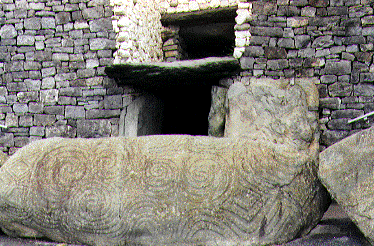

The entrance to Newgrange. Notice the decoration on the kerb stone in front. Also, notice the square above the door. It's through that square that sunlight enters during the Winter Solstice.
Newgrange is easily the most fascinating archeological site that I've visited. Just the fact that it's older than the Pyramids of Egypt makes it special. But, the fact that it was built with engineering and astronomical standards that are modern even by today's criteria makes it even more unique. Newgrange is one of three burial tombs in the area known as Bru na Boinne. The other two sites are Knowth and Dowth. Knowth is actually larger than Newgrange. However, excavations are still ongoing at this site. While visitors can visit the site, they cannot enter the tomb itself. The privilege of visiting the site isn't available at Dowth, where earlier excavations have ruined the tomb. You can only see Dowth from the road leading to the other two tombs.
Actually, you can't visit any of the tombs directly. Well, you can go to the sites; but, you'll be turned away and sent to the Bru na Boinne Visitor's Center a couple of miles to the south. The center is a collection point for all the tourists who want to visit either (or both) Newgrange or Knowth. The center has different opening hours throughout the year. From June until Mid September, it's open from 9 a.m until 7 p.m. There are also different charges depending on what one wants to see. To see the Center and Newgrange, it costs IŁ3 for adults, IŁ1.50 for senior citizens, and IŁ1.25 for students and children.
As I mentioned on the August 7 page, we got to the visitor's center just before it opened. I can't emphasize enough how effective this strategy is. We saw ample evidence of what happens when people wait until later in the day to go to the tomb. One has to realize that Newgrange has limited space inside of it (it holds about 25 people). So, one group can enter it about every 20 minutes. You can see from the math that it doesn't take long to for lines to develop. Thus, my advice is to get there very early so that you're one of the first groups to go to the tomb.
We bought our tickets for the bus to Newgrange. We would've gone to Knowth also; but, that tour would've added another hour to the trip. Because we had to get back to Dublin, we decided not to tour Knowth. The tour of Newgrange left the center's bus station at 9:30 a.m. We took advantage of the time before the bus left to tour the Visitor's Center. The center has many wonderful exhibits displaying the theories on who the people that built these tombs were, the ways that they built them, and the potential purposes for them. It's a good introduction to the area. After our quick tour, we walked on a bridge across the Boyne River to the center's bus terminal. There, we boarded our bus for the tomb.
The bus driver took a very circuitous route. A couple of times, we drove over roads on which we had driven just moments before. At first, I thought he wasn't sure of the way. Then, I began to wonder if he was backtracking on purpose in order to confuse the passengers so that we wouldn't find our way back to the tomb. I never got an answer to the question. But, eventually, he did drop us off at the tomb. The tomb is a grass covered mound with a white quartz exterior. It sits on top of a small hill overlooking the Boyne River. At the base of the hill is a small house. That is where we met our guide, who escorted us up to the tomb. After about 15 minutes of discussion on the location of the tomb and the ornamentation of the stones around it, we were led inside.
The passage to the center of the tomb is a little over 60 feet long. It's a narrow passage not suited for claustrophobic or overweight individuals. The end of the passage is a room with three sub-rooms branching off of it. The walls of the rooms are decorated with the same geometric designs as can be found on the kerb stones in front of the tomb. Inside these rooms, one can appreciate the advanced engineering that was used to build the structure. The layering of the stones to make the roof can clearly be seen. What's amazing is that the roof is so well designed that no water has leaked inside of it since it was completed. One also gets an appreciation of the "winter solstice effect " from inside the structure.
For the five days around and including the winter solstice (Dec. 19-23), sunrise light enters the chamber through a hole above the main door. The light fills the main chamber for about 20 minutes, then fades to return the interior to darkness. Since the main chamber only holds 25 people, there's quite a waiting list to be inside on the days when the effect takes place. Currently, the waiting list is filled until 2007. But, thanks to modern lighting technology, the effect is recreated for each group that visits the tomb. I have to admit, it's a little eerie when they turn off the lights to plunge the tomb into darkness. But, the simulation is very effective. It gives a very good representation of how the effect appears.
Newgrange, like Glendalough, is one of those places that have to be visited if one is going to Ireland. Just to be able to say that you stood inside one of the oldest structures in the world makes it worth the visit. I couldn't recommend it more. Just remember to get there early to avoid the crowds.